By Chern’ee Sutton
Age – 14 years
Size – 1 framed triptych 180cm wide x 115cm high
Medium – Acrylic and textured acrylic on canvas
Arrkun Ntia
My name is Chern’ee Sutton and I am a contemporary Indigenous artist from the Kalkadoon people from the Mount Isa area in Queensland. This painting is called “Arrkun Ntia” which means “Battle Mountain” in the Kalkadoon language.
The Kalkadoon people have always been an independent and proud people roving their hilly surrounds for thousands upon thousands of years normally in groups of 20 adults. They would camp for a few weeks at a time and live off the land until resources thinned out then they would move to another campsite and not return for 2 or 3 years so the wildlife and vegetation could replenish and survive. The Kalkadoon were extremely territorial and would rarely leave their country, they protected their land ferociously and were known to surrounding tribes as fearsome warriors.
The Kalkadoon people rule the emu foot province and were one of the last aboriginal tribes in Queensland to come into contact with whites. In 1861 the first white men Burke and Wills crossed through Kalkadoon tribal territory and with the establishment of Burketown in 1865 large numbers of settlers flooded south to Kalkadoon territory where traditional limited water and food supplies were threatened by the large numbers of European settlers.
The Kalkadoons patience was at an end by 1875 with more and more white people flooding to the area and sacred sites and water supplies being violated and so the Kalkadoon resistance started, mostly ambushing stock and horse pulled carts to start with then in 1878 three stockman were speared and killed along with their herd of cattle while they were camping at a waterhole that was a sacred Kalkadoon site. From this point onwards the Kalkadoon waged war against the whites using battle techniques not seen before that have now been studied by armies around the world. The Kalkadoon warriors would attack several different outposts at once ensuring that no reinforcements could be sent, they also used their bush skills and would attack a party with spears then disappear back into the bush before the first spear had struck its target. For the next few years the Kalkadoon people used guerrilla warfare to win a series of decisive victories over the whites.
Early in 1883 the officer in charge of the Cloncurry native police Marcus Beresford was attacked with 4 of his troopers while tracking Kalkadoon warriors in the McKinley ranges. Beresford and 3 of his troopers were killed with the fourth trooper walking 20 miles with a spear still in his thigh to raise the alarm. For the next year the hills and surrounding area was Kalkadoon country once more with the white people not venturing too far from the safety of Cloncurry. Late in 1883 Frederick Charles Urquhart was appointed the new sub inspector of the Native Police in Cloncurry and set about restocking horses and native troopers moving their camp 20 miles out of town to maintain discipline.
In the middle of 1884 James Powell was speared to death while mustering cattle, he was the co owner of Carlton Hills Station with Alexander Kennedy. When Kennedy heard the news of his partner’s death he rode eighty kilometres with his men to meet up with sub inspector Urquhart and his troopers and join forces. They then tracked the Kalkadoon warriors and trapped them in a gorge killing all the war party as well as women and children. Over the next months private posses and the new Native Police took a heavy toll on the Kalkadoon people and when a Chinese shepherd was killed in September the stations owner gathered a large number of men to join forces with Urquhart’s Native Police creating the first paramilitary force in Australia.
The Kalkadoon were tracked 60 miles north of Cloncurry to a place now known as Battle Mountain where over 900 Kalkadoon lay in wait. The Kalkadoon had chosen this place for the battle to take place they had stockpiled spears, boomerangs and rocks and the view from the mountain overlooked the plain below giving the tactical advantage to the Kalkadoon.
Sub inspector Urquhart started the battle by ordering the Kalkadoon to stand in the Queen’s name, they replied with a battle cry and hundreds of rocks thrown down the mountain. Urquhart then ordered a cavalry charge of 200 men on horseback up the mountain, their bullets bouncing off the rocks the Kalkadoon were using as cover and after 30 metres the horses could no longer climb the steep mountain and the men had to dismount and run for cover under a hail of spears. From high above the warriors shouted in defiance and continued their assault with rocks thrown down the mountain and while Urquhart was trying to regain control of his men and the battle he was hit in the head by a rock thrown by a large Kalkadoon warrior and fell unconscious to the ground. The native police temporarily abandoned other dead and dying and rushed to save their leader under a wall of covering rifle fire and with their leader saved but unconscious for hours the white army could offer no fight to the Kalkadoon warriors that were still raining rocks down the mountain.
When Sub Inspector Urquhart regained consciousness he immediately halved his army and flanked the mountain ready for an assault on two sides, it looked like the Kalkadoon warriors had little choice but to leave the cover of the boulders and prepare to defend in the open on two fronts. Upon seeing the flanking movement by Urquhart the Kalkadoon warriors left their cover and quickly formed ranks and without warning the warriors charged down the mountain with spears raised. The Kalkadoon lines with the pride and history of over 60,000 years of culture held for a brief moment as they charged their attackers and then as if history itself was being erased from the earth the Kalkadoon warriors were cut down by round after round after round of rifle fire. The brave remaining Kalkadoon warriors waivered but not able to accept defeat, this was their land they had no choice so they reformed their lines and again charged their attackers. Again the mountain rang with rifle fire that mowed down the charging warriors, after a while the rifle fire stopped and so too had the Kalkadoon resistance. Kalkadoon women knowing what was to come and left with no other choice placed their young children in dingo caves to hide them from harm. Urquhart was not satisfied with the slaughter that had taken place and for several days with his native troopers commenced a cleaning up operation where any Kalkadoon survivors found including women and children were also killed.
A lone reminder of one of Australia’s fiercest battles is a memorial obelisk near Battle Mountain which reads:
This obelisk is in memorial to the Kalkatunga tribe, who during September 1884 fought one of Australia`s historical battles of resistance against a Para-military force of European settlers and the Queensland Native Mounted Police at a place known to-day as Battle Mountain - 20 klms south west of Kajabbi. The spirit of the Kalkatunga tribe never died at battle, but remains intact and alive today within the Kalkadoon Tribal Council. "Kalkatunga heritage is not the name behind the person, but the person behind the name."
In my painting the red sky represents the spilt blood of my people, the yellow ochre represents the land for which they fought and the black represents the spirits of fierce, brave kalkadoon warriors with the dots, circles and lines that represent the battle between the aborigines and the white man. The broken boomerang and spear symbolize the battle that was bravely fought and lost with the white man leaving his footprint forever.
Only 29 Kalkadoon people survived the battle of Battle Mountain.
For me this painting is a tribute to my people’s courage and it also represents remembering the past and moving forward into the future!








